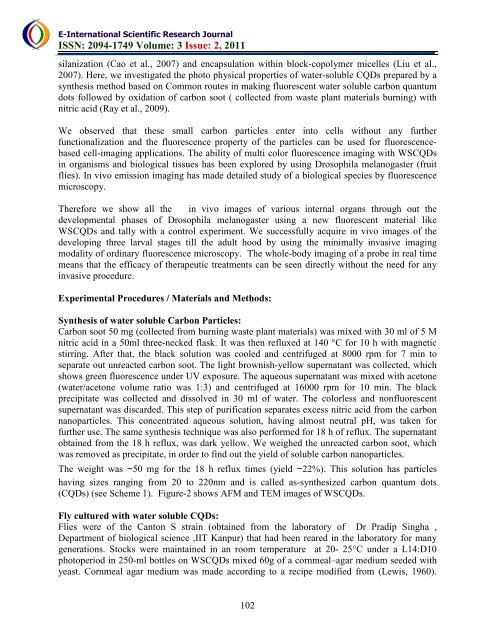download the full article here - E-International Scientific Research ...
download the full article here - E-International Scientific Research ...
download the full article here - E-International Scientific Research ...
Create successful ePaper yourself
Turn your PDF publications into a flip-book with our unique Google optimized e-Paper software.
E-<strong>International</strong> <strong>Scientific</strong> <strong>Research</strong> Journal<br />
ISSN: 2094-1749 Volume: 3 Issue: 2, 2011<br />
silanization (Cao et al., 2007) and encapsulation within block-copolymer micelles (Liu et al.,<br />
2007). Here, we investigated <strong>the</strong> photo physical properties of water-soluble CQDs prepared by a<br />
syn<strong>the</strong>sis method based on Common routes in making fluorescent water soluble carbon quantum<br />
dots followed by oxidation of carbon soot ( collected from waste plant materials burning) with<br />
nitric acid (Ray et al., 2009).<br />
We observed that <strong>the</strong>se small carbon p<strong>article</strong>s enter into cells without any fur<strong>the</strong>r<br />
functionalization and <strong>the</strong> fluorescence property of <strong>the</strong> p<strong>article</strong>s can be used for fluorescencebased<br />
cell-imaging applications. The ability of multi color fluorescence imaging with WSCQDs<br />
in organisms and biological tissues has been explored by using Drosophila melanogaster (fruit<br />
flies). In vivo emission imaging has made detailed study of a biological species by fluorescence<br />
microscopy.<br />
T<strong>here</strong>fore we show all <strong>the</strong> in vivo images of various internal organs through out <strong>the</strong><br />
developmental phases of Drosophila melanogaster using a new fluorescent material like<br />
WSCQDs and tally with a control experiment. We success<strong>full</strong>y acquire in vivo images of <strong>the</strong><br />
developing three larval stages till <strong>the</strong> adult hood by using <strong>the</strong> minimally invasive imaging<br />
modality of ordinary fluorescence microscopy. The whole-body imaging of a probe in real time<br />
means that <strong>the</strong> efficacy of <strong>the</strong>rapeutic treatments can be seen directly without <strong>the</strong> need for any<br />
invasive procedure.<br />
Experimental Procedures / Materials and Methods:<br />
Syn<strong>the</strong>sis of water soluble Carbon P<strong>article</strong>s:<br />
Carbon soot 50 mg (collected from burning waste plant materials) was mixed with 30 ml of 5 M<br />
nitric acid in a 50ml three-necked flask. It was <strong>the</strong>n refluxed at 140 °C for 10 h with magnetic<br />
stirring. After that, <strong>the</strong> black solution was cooled and centrifuged at 8000 rpm for 7 min to<br />
separate out unreacted carbon soot. The light brownish-yellow supernatant was collected, which<br />
shows green fluorescence under UV exposure. The aqueous supernatant was mixed with acetone<br />
(water/acetone volume ratio was 1:3) and centrifuged at 16000 rpm for 10 min. The black<br />
precipitate was collected and dissolved in 30 ml of water. The colorless and nonfluorescent<br />
supernatant was discarded. This step of purification separates excess nitric acid from <strong>the</strong> carbon<br />
nanop<strong>article</strong>s. This concentrated aqueous solution, having almost neutral pH, was taken for<br />
fur<strong>the</strong>r use. The same syn<strong>the</strong>sis technique was also performed for 18 h of reflux. The supernatant<br />
obtained from <strong>the</strong> 18 h reflux, was dark yellow. We weighed <strong>the</strong> unreacted carbon soot, which<br />
was removed as precipitate, in order to find out <strong>the</strong> yield of soluble carbon nanop<strong>article</strong>s.<br />
The weight was ∼50 mg for <strong>the</strong> 18 h reflux times (yield ∼22%). This solution has p<strong>article</strong>s<br />
having sizes ranging from 20 to 220nm and is called as-syn<strong>the</strong>sized carbon quantum dots<br />
(CQDs) (see Scheme 1). Figure-2 shows AFM and TEM images of WSCQDs.<br />
Fly cultured with water soluble CQDs:<br />
Flies were of <strong>the</strong> Canton S strain (obtained from <strong>the</strong> laboratory of Dr Pradip Singha ,<br />
Department of biological science ,IIT Kanpur) that had been reared in <strong>the</strong> laboratory for many<br />
generations. Stocks were maintained in an room temperature at 20- 25°C under a L14:D10<br />
photoperiod in 250-ml bottles on WSCQDs mixed 60g of a cornmeal–agar medium seeded with<br />
yeast. Cornmeal agar medium was made according to a recipe modified from (Lewis, 1960).<br />
102

















